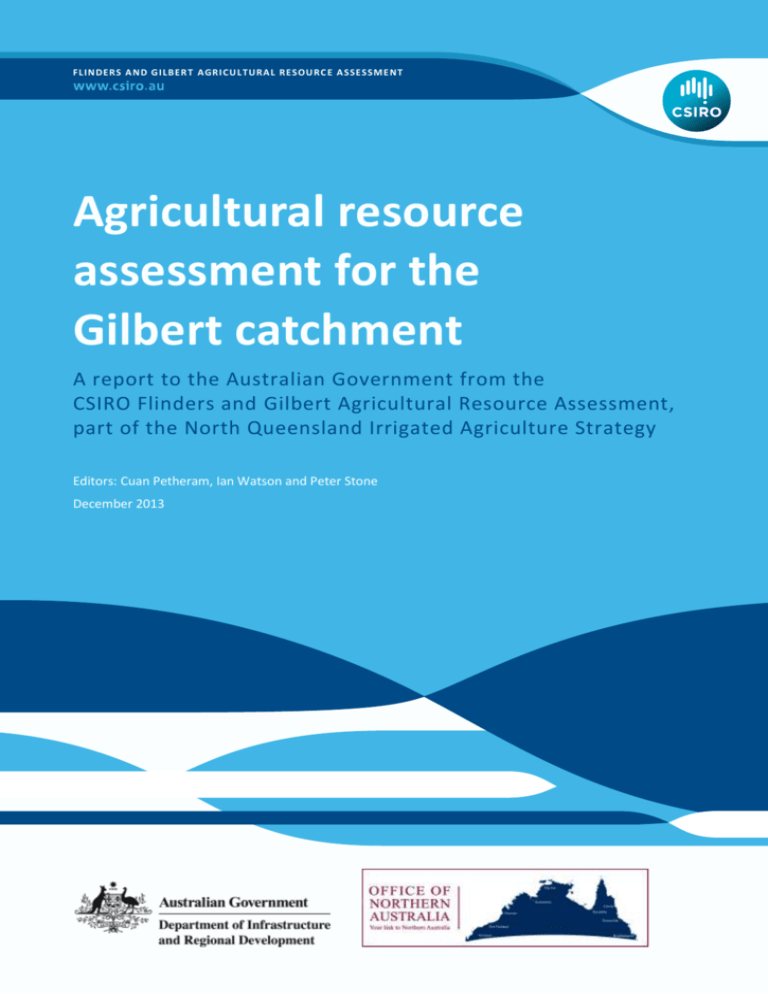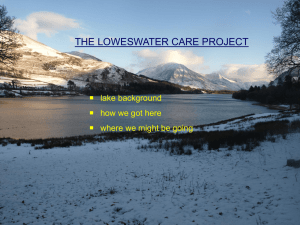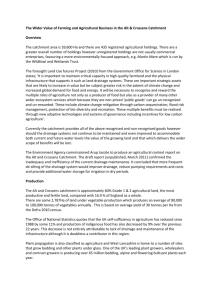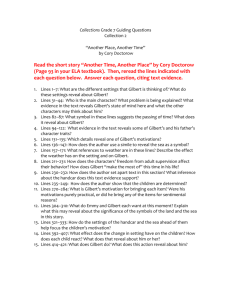
F LIN DERS A N D G I LBER T AGRI CU LTURA L RES OU RC E A SSESSME NT
Agricultural resource
assessment for the
Gilbert catchment
A report to the Australian Government from the
CSIRO Flinders and Gilbert Agricultural Resource Assessment,
part of the North Queensland Irrigated Agriculture Strategy
Editors: Cuan Petheram, Ian Watson and Peter Stone
December 2013
Water for a Healthy Country Flagship Report series ISSN: 1835-095X
Australia is founding its future on science and innovation. Its national science agency, CSIRO, is a powerhouse of ideas, technologies and skills.
CSIRO initiated the National Research Flagships to address Australia’s major research challenges and opportunities. They apply large scale, long
term, multidisciplinary science and aim for widespread adoption of solutions. The Flagship Collaboration Fund supports the best and brightest
researchers to address these complex challenges through partnerships between CSIRO, universities, research agencies and industry.
Consistent with Australia’s national interest, the Water for a Healthy Country Flagship aims to develop science and technologies that improve the
social, economic and environmental outcomes from water, and deliver $3 billion per year in net benefits for Australia by 2030. The Sustainable
Agriculture Flagship aims to secure Australian agriculture and forest industries by increasing productivity by 50 percent and reducing carbon
emissions intensity by at least 50 percent by 2030.
For more information about Water for a Healthy Country Flagship, Sustainable Agriculture Flagship or the National Research Flagship Initiative visit
<http://www.csiro.au/flagships>.
Citation
Petheram C, Watson I and Stone P (eds) (2013) Agricultural resource assessment for the Gilbert catchment. A report to the Australian Government
from the CSIRO Flinders and Gilbert Agricultural Resource Assessment, part of the North Queensland Irrigated Agriculture Strategy. CSIRO Water for
a Healthy Country and Sustainable Agriculture flagships, Australia.
Chapters should be cited in the format of the following example: Petheram C, Watson I, Marston F, Buettikofer B and Stone P (2013) Chapter 1:
Preamble. In: Petheram C, Watson I and Stone P (eds) Agricultural resource assessment for the Gilbert catchment. A report to the Australian
Government from the CSIRO Flinders and Gilbert Agricultural Resource Assessment, part of the North Queensland Irrigated Agriculture Strategy.
CSIRO Water for a Healthy Country and Sustainable Agriculture flagships, Australia.
Copyright
© Commonwealth Scientific and Industrial Research Organisation 2013. To the extent permitted by law, all rights are reserved and no part of this
publication covered by copyright may be reproduced or copied in any form or by any means except with the written permission of CSIRO.
Important disclaimer
CSIRO advises that the information contained in this publication comprises general statements based on scientific research. The reader is advised
and needs to be aware that such information may be incomplete or unable to be used in any specific situation. No reliance or actions must
therefore be made on that information without seeking prior expert professional, scientific and technical advice. To the extent permitted by law,
CSIRO (including its employees and consultants) excludes all liability to any person for any consequences, including but not limited to all losses,
damages, costs, expenses and any other compensation, arising directly or indirectly from using this publication (in part or in whole) and any
information or material contained in it.
Flinders and Gilbert Agricultural Resource Assessment acknowledgments
This report was prepared for the Office of Northern Australia in the Australian Government Department of Infrastructure and Regional
Development under the North Queensland Irrigated Agriculture Strategy <http://www.regional.gov.au/regional/ona/nqis.aspx>. The Strategy is a
collaborative initiative between the Office of Northern Australia, the Queensland Government and CSIRO. One part of the Strategy is the Flinders
and Gilbert Agricultural Resource Assessment, which was led by CSIRO. Important aspects of the Assessment were undertaken by the Queensland
Government and TropWATER (James Cook University).
The Strategy was guided by two committees:
(i) the Program Governance Committee, which included the individuals David Crombie (GRM International), Scott Spencer (SunWater, during the
first part of the Strategy) and Paul Woodhouse (Regional Development Australia) as well as representatives from the following organisations:
Australian Government Department of Infrastructure and Regional Development; CSIRO; and the Queensland Department of Agriculture, Fisheries
and Forestry.
(ii) the Program Steering Committee, which included the individual Jack Lake (Independent Expert) as well as representatives from the following
organisations: Australian Government Department of Infrastructure and Regional Development; CSIRO; the Etheridge, Flinders and McKinlay shire
councils; Gulf Savannah Development; Mount Isa to Townsville Economic Development Zone; and the Queensland Government.
Chapters 1 to 7 of this report were reviewed by Dr Graham Bonnett (CSIRO Plant Industry) and Dr Glen Walker (CSIRO Land and Water).
Dr Brian Keating (Sustainable Agriculture Flagship) and Dr Peter Wallbrink (Water for a Healthy Country Flagship) reviewed the entire report. The
following people reviewed all or part of one or more case studies (chapters 8 to 10): Dr Andrew Ash (CSIRO Ecosystem Sciences) and Dr Brad Pusey
(River Research Pty Ltd).
For further acknowledgements, see page vi.
v20140430a
Director’s foreword
Northern Australia comprises approximately 20% of Australia’s land mass but remains relatively
undeveloped. It contributes about 2% to the nation’s gross domestic product (GDP) and accommodates
around 1% of the total Australian population.
Recent focus on the shortage of water and on climate-based threats to food and fibre production in the
nation’s south have re-directed attention towards the possible use of northern water resources and the
development of the agricultural potential in northern Australia. Broad analyses of northern Australia as a
whole have indicated that it is capable of supporting significant additional agricultural and pastoral
production, based on more intensive use of its land and water resources.
The same analyses also identified that land and water resources across northern Australia were already
being used to support a wide range of highly valued cultural, environmental and economic activities. As a
consequence, pursuit of new agricultural development opportunities would inevitably affect existing uses
and users of land and water resources.
The Flinders and Gilbert catchments in north Queensland have been identified as potential areas for further
agricultural development. The Flinders and Gilbert Agricultural Resource Assessment (the Assessment), of
which this report is a part, provides a comprehensive and integrated evaluation of the feasibility, economic
viability and sustainability of agricultural development in these two catchments as part of the North
Queensland Irrigated Agricultural Strategy. The Assessment seeks to:
identify and evaluate water capture and storage options
identify and test the commercial viability of irrigated agricultural opportunities
assess potential environmental, social and economic impacts and risks.
By this means it seeks to support deliberation and decisions concerning sustainable regional development.
The Assessment differs from previous assessments of agricultural development or resources in two main
ways:
It has sought to ‘join the dots’. Where previous assessments have focused on single development
activities or assets – without analysing the interactions between them – this Assessment considers the
opportunities presented by the simultaneous pursuit of multiple development activities and assets. By
this means, the Assessment uses a whole-of-region (rather than an asset-by-asset) approach to
consider development.
The novel methods developed for the Assessment provide a blueprint for rapidly assessing future land
and water developments in northern Australia.
Importantly, the Assessment has been designed to lower the barriers to investment in regional
development by:
explicitly addressing local needs and aspirations
meeting the needs of governments as they regulate the sustainable and equitable management of
public resources with due consideration of environmental and cultural issues
meeting the due diligence requirements of private investors, by addressing questions of profitability
and income reliability at a broad scale.
Most importantly, the Assessment does not recommend one development over another. It provides the
reader with a range of possibilities and the information to interpret them, consistent with the reader’s
values and their aspirations for themselves and the region.
Dr Peter Stone, Deputy Director, CSIRO Sustainable Agriculture Flagship
Director’s foreword | i
Key findings
North Queensland’s Gilbert catchment, comprising an area of approximately 46,000 km2, drains into the
southern Gulf of Carpentaria. Its population of approximately 1200 people is engaged mainly in
pastoralism, but tourism, mining and commercial fishing make important contributions to the economy.
Dryland and irrigated cropping currently occupy less than 0.02% of the landscape.
This report on the Gilbert catchment seeks to:
identify and evaluate water capture and storage options
identify and test the commercial viability of irrigated agricultural opportunities
assess potential environmental, social and economic impacts and risks.
The Assessment acknowledges that locals have insights, skills and aspirations to contribute to development
plans for the benefit of their region, community and environment. Scientific knowledge of the type
produced by this Assessment should complement rather than compete with local knowledge.
Water capture and storage options
Two prospective instream water storages (dams) of significant scale have been identified (Green Hills and
Dagworth dams). When combined, these two dams are capable of delivering to crops approximately
250 gigalitres (GL) of water in 85% of years. The next four most prospective instream dams add relatively
small volumes of water at relatively high cost.
There is more soil suited to irrigation in the Gilbert catchment than there is water to irrigate it. If the most
prospective six instream storages were to exist, it would be possible to irrigate approximately 0.6% of the
catchment’s irrigable soils.
On-farm dams are considered less prospective because of the catchment’s often sandy soils, though there
are locations suited to on-farm water storage.
Agricultural opportunities
Based on the identified water storage and the large areas of potentially irrigable agricultural soils
(approximately 2 million ha), there is the potential for an irrigation development of 20,000 to 30,000 ha
supporting year-round mixed irrigated and dryland cropping. The precise area under irrigation will, in any
year, vary depending on factors such as irrigation efficiency, water availability, crop choice and risk
appetite. A development of this scale is larger than the existing Ord River Irrigation Area, and may be
sufficient to sustain local processing facilities such as a cotton gin or a sugarcane mill. If crops were grown
to their full potential, the regional gross margin of crop production could exceed $60 million/year.
Dryland production is sensitive to the very high year-to-year variability of rainfall in the Gilbert catchment.
Break-even yields of most crops can be achieved only two to three years in ten, which precludes
commercial returns on development costs such as land clearing. If these costs are ‘sunk’, commercial
returns from dryland cropping require that crops approach their full yield potential and that they are grown
only in years when cropping opportunity is high. This can be clearly distinguished at sowing time using
seasonal rainfall outlooks and information about water stored in dams and in soil. Despite these challenges,
dryland cropping is likely to be a component of irrigation development.
Environmental impacts and risks
Irrigated agricultural development has a wide range of potential benefits and risks.
The two most prospective dams would, in the downstream environment, amplify the environmental and
other challenges associated with dry years. Critical environmental processes (such as wetland inundation)
ii | Agricultural resource assessment for the Gilbert catchment
would not be greatly affected by water extraction in ‘average’ or wet years, largely because the dams
would be located in the middle reaches of the catchment and would intercept a mean 14% and median
20% of flow to the Gulf of Carpentaria. Impacts of reduced river discharges to the Gulf on commercial and
recreational fishing catches are possible but have not been quantified in this study. Large-scale change of
land and water use is likely to require a wide range of regulatory, social and cultural responses, including
consideration of native title implications.
Under the development scenarios examined, the high capital costs of dams and water delivery
infrastructure (approximately $1 billion) precludes economic returns on combined investment in water
assets and irrigated farming. Where third-party investment in water storage and delivery was examined, it
was found that commercial returns on irrigated agriculture are possible when crops approached their full
yield potential – a condition that becomes more probable with experience.
Key deliverables
This report is one of two catchment reports within a suite of products provided by the Assessment to fulfil
its contractual obligations:
Technical reports present scientific work at a level of detail sufficient for technical and scientific
experts to reproduce the work.
Each of the two catchment reports (i.e. this report and another for the Flinders catchment) synthesises
key material from the technical reports, providing well-informed but non-scientific readers with the
information required to make decisions about the opportunities, costs and benefits associated with
irrigated agriculture.
Two overview reports – one for each catchment – are provided for a general public audience.
A factsheet provides key findings for both the Flinders and Gilbert catchments for a general public
audience.
All these products are listed in full in Appendix A.
Key findings | iii
The Flinders and Gilbert Agricultural Resource
Assessment team
Project Director
Peter Stone
Project Leaders
Cuan Petheram, Ian Watson
Reporting Team
Heinz Buettikofer, Becky Schmidt, Maryam Ahmad, Simon Gallant,
Frances Marston, Greg Rinder, Audrey Wallbrink
Project Support
Ruth Palmer, Daniel Aramini, Michael Kehoe, Scott Podger
Communications
Leane Regan, Claire Bobinskas, Dianne Flett2, Rebecca Jennings
Data Management
Mick Hartcher
Activities
Agricultural productivity
Tony Webster, Brett Cocks, Jo Gentle6, Dean Jones, Di Mayberry,
Perry Poulton, Stephen Yeates, Ainsleigh Wixon
Aquatic and riparian ecology
Damien Burrows1, Jon Brodie1, Barry Butler1, Cassandra James1,
Colette Thomas1, Nathan Waltham1
Climate
Cuan Petheram, Ang Yang
Flood mapping
Dushmanta Dutta, Fazlul Karim, Steve Marvanek, Cate Ticehurst
Geophysics
Tim Munday, Tania Abdat, Kevin Cahill, Aaron Davis
Groundwater
Ian Jolly, Andrew Taylor, Phil Davies, Glenn Harrington,
John Knight, David Rassam
Indigenous water values
Marcus Barber, Fenella Atkinson5, Michele Bird2, Susan McIntyreTamwoy5
Instream waterholes
David McJannet, Anne Henderson, Jim Wallace1
Irrigation infrastructure
John Hornbuckle
Land suitability
Rebecca Bartley, Daniel Brough3, Charlie Chen, David Clifford,
Angela Esterberg3, Neil Enderlin3, Lauren Eyres3, Mark Glover,
Linda Gregory, Mike Grundy, Ben Harms3, Warren Hicks,
Joseph Kemei, Jeremy Manders3, Keith Moody3, Dave Morrison3,
Seonaid Philip, Bernie Powell3, Liz Stower, Mark Sugars3,
Mark Thomas, Seija Tuomi, Reanna Willis3, Peter R Wilson2
River modelling
Linda Holz, Julien Lerat, Chas Egan3, Matthew Gooda3,
Justin Hughes, Shaun Kim, Alex Loy3, Jean-Michel Perraud,
Geoff Podger
iv | Agricultural resource assessment for the Gilbert catchment
Socio-economics
Lisa Brennan McKellar, Neville Crossman, Onil Banerjee,
Rosalind Bark, Andrew Higgins, Luis Laredo, Neil MacLeod,
Marta Monjardino, Carmel Pollino, Di Prestwidge, Stuart Whitten,
Glyn Wittwer4
Water storage
Cuan Petheram, Geoff Eades2, John Gallant, Paul Harding3,
Ahrim Lee3, Sylvia Ng3, Arthur Read, Lee Rogers, Brad Sherman,
Kerrie Tomkins, Sanne Voogt3
Note: all contributors are affiliated with CSIRO unless indicated otherwise. Activity Leaders are underlined. 1 TropWATER, James Cook University,
2
Independent consultant, 3 Queensland Government, 4 Monash University, 5 Archaeological Heritage Management Solutions, 6University of Western
Sydney
The Flinders and Gilbert Agricultural Resource Assessment team | v
Acknowledgements
A large number of people provided a great deal of help, support and encouragement to the Flinders and
Gilbert Agricultural Resource Assessment (the Assessment) team over the past two years. Their
contribution was generous and enthusiastic and we could not have completed the work without them. We
are particularly indebted to the local community of the Flinders and Gilbert catchments and from a range of
people in Queensland state government departments and elsewhere. Many of our work colleagues also
provided critical expertise and support.
Each of the accompanying technical reports (see Appendix A) contains its own set of acknowledgements.
Here we acknowledge those people who went ‘above and beyond’ and who contributed across the
Assessment activities.
The communities of the Flinders and Gilbert catchments enthusiastically embraced the Assessment team.
They provided: (i) hospitality, (ii) historical and contextual information, (iii) access to land and help in
finding waterholes, bores, promising dam sites and other features, (iv) unpublished reports, and (v)
answers to a bewildering array of questions from the Assessment team. Importantly, they also gave us ‘the
time of day’, showing us around the catchment and their landholdings and providing the local context that
is so important for work of this kind. In particular, we thank the members of FRAP, the Flinders River
Agricultural Precinct. Brendan McNamara as Chair was welcoming from the beginning. Corbett Tritton,
Chair of the Flinders River Agricultural Precinct Growers Group and a local grazier and irrigator was
generous with his time, expertise and insights into agricultural development as well as providing access to
his crops for the Assessment team to collect data. Ninian Stewart-Moore, Brian Hughes, Ardie Lord,
Darren Beeton, Alistair McClymont, Edward McIntosh, Scott Harris, Campbell Keough, David and
Kenneth Coleman, Colin Blacklock, Ray Theme, Jacqueline and Robert Curley as well as many other
landholders helped the Assessment team. Brad Bowen and Ken and Brendan Fry took us through their
existing irrigated enterprises. Grant Randell contributed both his expertise and his land and water to help
us understand the opportunities for a range of crops. Landholders also contributed their time to formal
surveys of their attitudes to agricultural development in the two catchments. Julie Harrison, the FRAP
Project Officer, provided an enormous amount of assistance to the Assessment team. If Julie didn’t know
the answer to a question, she put us in touch with someone who did. She helped organise our contacts
with the local community and, importantly, Julie was such an enthusiastic supporter and advocate of the
Assessment team that she provided the credibility that we needed for others to contribute their thoughts,
expertise and information.
Local government support in both catchments was critical. The mayors and CEOs of the six relevant shires
encouraged their staff to support the Assessment. In particular, Will Attwood, Ian Tincknell and the
councillors of the Etheridge Shire gave freely of their time. Lew Rohjan and Steve McCartney were
invaluable providers of information and local context. Noelene Ikin, Michael Digby and Tim Hoogwerf from
Northern Gulf NRM provided digital and other information. Members of the Mt Isa to Townsville Economic
Development Zone and Gulf Savannah Development, in particular, Glen Graham, Mark Shadur and
Rob McAllister provided us with unpublished reports and other support. Warren Devlin and Peter Gilbey
gave us advice on water storage opportunities.
Members of Indigenous communities from the two catchments provided the Assessment team with deep
perspectives on the land, its history and its prospects for agricultural development. Many individuals gave
up their time for interviews and discussion. In particular we’d like to thank members of the Carpentaria
and North Queensland land councils, the Normanton and the Ewamian rangers, and the Yirendali,
Wanamara, Mitakoodi, Gkuthaarn and Kukatj, Ewamian, Kurtijar, Kalkadoon and Tagalaka people.
The Assessment team received tremendous support from a large number of people in Queensland
government departments. They are too numerous to all be mentioned here but they not only provided
access to files and reports, access to spatial and other data, information on legislation and regulations,
vi | Agricultural resource assessment for the Gilbert catchment
access to groundwater bores and answered innumerable questions but they also provided the team with
their professional expertise and encouragement. They included, but are not limited to Daniel Larsen,
Nigel Kelly, Andrew Zull, Dan Brough, Bernie Powell and Neil Enderlin. In particular, we thank Steph Hogan
for information and advice on water planning and regulation. Gareth Jones and Greg Mason, who have
both worked in the district for a number of years, showed us around the catchments, helped us make
contact with landholders, contributed to the agronomic trials, provided access to unpublished information
and linked us to other state government resources. Gareth and Greg enthusiastically embraced the
Assessment team from the beginning and we could not have completed the work without them.
The North Queensland Irrigated Agriculture Strategy’s steering committee and governance committee
provided us with wise counsel, good advice and the confidence that the Assessment was progressing well.
The Stakeholder Engagement and Communication Strategy working group, especially Bec Jennings and
Vern Rudwick, was instrumental in ensuring cross-agency co-ordination and provided communication
products to stakeholders.
Our client, the Office of Northern Australia, provided us with the challenge of attempting such a complex
multi- and inter-disciplinary project in a very short time. Andrew Dickson, Lee Chaney and Peter Mellor
were critical to ensuring the Assessment proceeded smoothly.
A long list of expert reviewers provided advice that improved the quality of our methods report, the various
technical reports and the two catchment reports.
Colleagues in CSIRO and elsewhere provided freely of their time and expertise to help with the Assessment.
This was often at short notice and of sufficient scale that managing their commitment to other projects
became challenging. The list is long, but we’d particularly like to thank Andrew Ash, Chris Stokes,
Andrew Johnson, Liz Stower, Mike Grundy, Peter L Wilson, Robyn Cowley, Cam McDonald, Lindsay Bell,
Jizelle Khoury, Peter Wallbrink, David Lemon, Brett Baker and Aaron Hawdon. CSIRO administrative,
financial and legal staff provided great support, especially Sharyn Butts, Ali Wood, Fiona Johnstone,
John Nappo, Jacqui Watt, Nicole Smith, Kristina Roberts, Ken Currie and Cie Rogers. Many other people,
including Wayne Lillyman and Bernie Cornfoot provided costings or technical expertise to allow us to
produce accurate modelling of development opportunities.
Finally, the complexity and scale of this Assessment meant that we spent more time away from our families
than we might otherwise have chosen. The whole team recognises this can only happen with the love and
support of our families, so thank you.
Acknowledgements | vii
Contents
Director’s foreword ............................................................................................................................................. i
Key findings ........................................................................................................................................................ ii
The Flinders and Gilbert Agricultural Resource Assessment team ................................................................... iv
Acknowledgements ........................................................................................................................................... vi
Contents .......................................................................................................................................................... viii
Part I
Introduction
1
Preamble ............................................................................................................................................... 2
1.1 Context: development in northern Australia .............................................................................. 2
1.2 Flinders and Gilbert Agricultural Resource Assessment ............................................................. 4
1.3 Report objectives and structure ................................................................................................. 6
1.4 References .................................................................................................................................. 8
2
Key concepts and Assessment methods .............................................................................................10
2.1 Key concepts .............................................................................................................................10
2.2 Assessment methods ................................................................................................................12
2.3 References ................................................................................................................................29
Part II Information for assessing potential scheme-scale and farm-scale irrigation developments
1
33
3
Physical environment of the Gilbert catchment .................................................................................34
3.1 Summary ...................................................................................................................................35
3.2 Geology .....................................................................................................................................36
3.3 Soils of the Gilbert catchment ..................................................................................................37
3.4 Climate ......................................................................................................................................47
3.5 Hydrology ..................................................................................................................................56
3.6 References ................................................................................................................................77
4
Living and built environment of the Gilbert catchment .....................................................................80
4.1 Summary ...................................................................................................................................81
4.2 Ecology of the Gilbert catchment .............................................................................................82
4.3 Indigenous pre-history and colonial history of the Gilbert catchment ....................................93
4.4 Indigenous water values, rights and interests and Indigenous development aspirations .....101
4.5 Broader social environmental values......................................................................................108
4.6 Catchment profile ...................................................................................................................108
4.7 References ..............................................................................................................................121
5
Opportunities for irrigation in the Gilbert catchment ......................................................................128
5.1 Summary .................................................................................................................................129
5.2 Water storage opportunities ..................................................................................................130
5.3 Water distribution systems – conveyance of water from storage to the crop ......................162
viii | Agricultural resource assessment for the Gilbert catchment
5.4
5.5
5.6
5.7
Land development for irrigation .............................................................................................171
Cropping and other agricultural opportunities.......................................................................172
Summary of dam and scheme-scale costs ..............................................................................220
References ..............................................................................................................................221
6
Overview of economic opportunities and constraints......................................................................226
6.1 Summary .................................................................................................................................227
6.2 Farm-scale opportunities ........................................................................................................228
6.3 Scheme-scale opportunities ...................................................................................................238
6.4 Legislation and regulation.......................................................................................................246
6.5 Regional-scale impacts............................................................................................................249
6.6 References ..............................................................................................................................249
7
How can the sustainability of irrigated agriculture be maximised? .................................................252
7.1 Summary .................................................................................................................................253
7.2 Risk of irrigation-induced salinisation.....................................................................................254
7.3 Managing irrigation drainage .................................................................................................262
7.4 Ecological implications of altered flow regimes .....................................................................264
7.5 References ..............................................................................................................................267
Part III Case studies
271
8
Green Hills dam and irrigated three-crop rotation ...........................................................................272
8.1 Summary .................................................................................................................................273
8.2 Storyline for this case study ....................................................................................................274
8.3 Soils near Green Hills ..............................................................................................................277
8.4 Climate suitability for cotton, peanuts and sorghum (forage) at Green Hills.........................279
8.5 Scheme configuration and cropping systems .........................................................................280
8.6 Financial analysis.....................................................................................................................287
8.7 On-site and off-site impacts....................................................................................................303
8.8 References ..............................................................................................................................307
9
Dagworth and Green Hills dams and irrigated sugarcane ................................................................310
9.1 Summary .................................................................................................................................311
9.2 Storyline for this case study ....................................................................................................312
9.3 Soils along the Gilbert and Einasleigh rivers ...........................................................................315
9.4 Climate suitability of sugarcane in the Georgetown area ......................................................319
9.5 Scheme configuration and cropping systems .........................................................................320
9.6 Financial analysis.....................................................................................................................328
9.7 On-site and off-site impacts....................................................................................................341
9.8 References ..............................................................................................................................346
10
Kidston Dam and irrigated Rhodes grass ..........................................................................................348
10.1 Summary .................................................................................................................................349
10.2 Storyline for this case study ....................................................................................................350
10.3 Soils near Einasleigh ................................................................................................................352
10.4 Geophysics investigation ........................................................................................................355
10.5 Climate suitability for irrigated forage crops near Einasleigh.................................................357
Contents | ix
10.6
10.7
10.8
10.9
Configuration of irrigation developments and cropping systems ..........................................358
Financial analysis.....................................................................................................................363
On-site and off-site impacts....................................................................................................373
References ..............................................................................................................................377
Appendixes
379
Appendix A .....................................................................................................................................................380
Assessment products ........................................................................................................................380
Appendix B......................................................................................................................................................383
Shortened forms ...............................................................................................................................383
Geological timeline............................................................................................................................385
Units ................................................................................................................................................386
Data sources and availability.............................................................................................................387
Glossary and terms............................................................................................................................389
Appendix C ......................................................................................................................................................391
List of figures .....................................................................................................................................391
Appendix D .....................................................................................................................................................400
List of tables ......................................................................................................................................400
x | Agricultural resource assessment for the Gilbert catchment
Part I Introduction
Chapters 1 and 2 provide background and context for the Assessment and outline the methods adopted to
undertake the work:
Chapter 1 covers the background and context of the Assessment.
Chapter 2 provides a high-level outline of the methods used by the Assessment. This information is
designed to assist in understanding the limitations to – and uncertainty associated with – the
information provided by the Assessment.
Readers will find these chapters provide the context for and critical foundational information about the
Assessment with key concepts introduced and explained.
For a synthesis of the key findings from the Assessment, see page ii.
Contents | i
2 | Agricultural resource assessment for the Gilbert catchment









